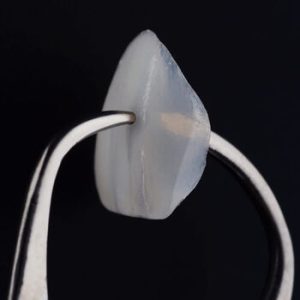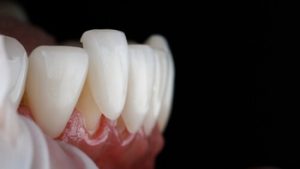Whether you’re dealing with chipped teeth, stubborn discolouration, or minor misalignment, porcelain veneers may be the transformative solution you’ve been looking for. This cosmetic procedure has helped millions of people restore the appearance of their smile and their confidence, without undergoing complex orthodontics or tooth replacement. In this guide, we’ll walk you through every step of the porcelain veneers procedure, explore the materials used, discuss alternatives like composite veneers, and answer the most common questions about getting veneers.
What Are Porcelain Veneers?
Porcelain veneers are extremely thin shells of porcelain designed to bond to the front of your teeth, enhancing their shape, shade, and overall look. Made to integrate naturally with your existing teeth, they address a broad range of cosmetic imperfections, such as:
- Chipped tooth
- Discoloured teeth
- Uneven teeth
- Gaps between teeth
- Crooked teeth
- Misshapen teeth
- Worn-down or broken teeth
These dental veneers are thin, yet durable, and are crafted from stain-resistant porcelain to mimic the look and translucency of natural teeth.
The Porcelain Veneers Procedure: Step-by-Step
Let’s break down the full porcelain veneers procedure, from your first consultation to walking out with your new smile.
 1. Initial Consultation
1. Initial Consultation
Your veneer’s journey starts with an initial consultation at the dentist’s office. At this visit, your cosmetic dentist will evaluate your teeth, discuss your concerns, and determine whether porcelain veneers are the right choice for your smile.
They may take X-rays or digital scans to evaluate your tooth structure and oral health. You’ll also discuss your smile goals, whether it’s closing gaps, brightening tooth colour, or correcting asymmetry.
This is also the time to explore your material options, including porcelain or composite veneers, depending on your budget and aesthetic goals.
2. Smile Design and Planning
Once veneers are confirmed as suitable, your dentist will design a custom treatment plan. This includes:
- Choosing the veneer shade to match your natural tooth colour
- Selecting the number of veneers (e.g., for front teeth only)
- Planning the shape, size, and positioning of each veneer
This stage may involve mock-ups or digital previews to help you visualise your new smile before the actual procedure begins.
3. Tooth Preparation
To create room for veneers and ensure a natural fit, a small amount of tooth enamel is removed from the front surface of each tooth. This tooth reduction is usually minimal, about 0.3 to 0.7mm, and is necessary for the veneers to look and feel natural.
Tooth preparation is considered an irreversible procedure because enamel cannot regenerate. For this reason, it’s essential to weigh the advantages and potential drawbacks with your cosmetic dentist before making a decision.
After enamel is removed, impressions of your existing teeth are taken and sent to a dental laboratory, where your custom veneers are crafted.
4. Temporary Veneers
As your permanent veneers are being created in the dental lab, your dentist will fit temporary ones to shield your treated teeth and offer a glimpse of your expected final smile.
These temporary dental veneers help maintain function and appearance during the waiting period, which typically lasts 1–2 weeks. You’ll need to take care during this time: avoid hard foods and brush gently, as these temporary restorations are more fragile than the final veneers.
5. Veneer Placement
Once your veneers are ready, you’ll return to the dental clinic for their final placement and secure bonding. Your dentist will:
- Evaluate the shape, fit, and shade of each veneer to ensure a natural appearance
- Make minor adjustments if needed
- Clean and polish your natural teeth
- Lightly roughen the enamel to promote a durable bond between the veneer and tooth
- Apply dental cement and carefully bond the veneers to your teeth
- Use a curing light to harden the cement
This final veneer procedure may take a few hours, depending on the number of veneers being placed.
Once everything is in place, you’ll leave the dentist’s office with a beautifully enhanced yet natural-looking smile.
Materials Used: Porcelain vs Composite Veneers
Veneers are available in a range of materials, each offering its own set of advantages and considerations.
Porcelain Veneers
Porcelain is the most popular and durable material for veneers. Porcelain veneers are known for:
- High stain resistance
- Natural appearance
- Long-lasting results (10–15 years or more)
- Superior translucency
They are also more resistant to chips and fractures than composite resin. Traditional porcelain veneers typically require more enamel removal compared to newer types like no-prep veneers, but the aesthetic result is unmatched.
Composite Veneers
Composite veneers, also known as composite resin veneers, use the same tooth-coloured substance as dental bonding procedures. Composite veneer options are more affordable than porcelain and require less tooth preparation. However, they tend to stain more easily and generally last 5 to 7 years.
There are also composite tooth veneers that can be sculpted directly in the mouth in a single appointment, making them a quicker but less durable alternative.
If you’re unsure which type is right for you, your dentist can guide you through the differences between porcelain and composite veneers.
Are Veneers Permanent?
The answer is yes. In most cases, veneers are permanent. This is because the procedure involves tooth reduction, which alters the natural tooth structure. Once tooth enamel is removed, it cannot be restored, and you’ll always need a veneer or other form of coverage to protect the tooth.
That said, veneers themselves are not lifetime devices. While porcelain veneer restorations are long-lasting, they may eventually need to be replaced due to:
- Wear and tear
- Gum recession
- Damage (e.g. from teeth grinding or trauma)
Your dentist will advise how long your veneers should last based on your oral habits, material choice, and aftercare.
Who Is a Good Candidate for Veneers?
Veneers are ideal for adults with healthy teeth and gums who want to correct cosmetic concerns such as:
- Stained or discoloured teeth (including internal stains not responsive to whitening treatments)
- Worn, chipped, or broken teeth
- Crooked teeth that don’t require full orthodontics
- Misshapen or small teeth
- Uneven spacing or gaps between front teeth
- Teeth that are too short or uneven in length
However, veneers aren’t suitable for everyone. Patients with significant tooth decay, periodontal disease, or large front-tooth fillings may be advised to consider alternatives such as dental crowns.
People who grind their teeth excessively or have thin enamel may also need additional precautions or consider partial veneers.
Advantages of Porcelain Veneers
Getting veneers offers a range of benefits, especially for patients looking to improve the appearance of their teeth without more invasive treatments.
 1. Aesthetic Enhancement
1. Aesthetic Enhancement
Porcelain dental veneers significantly enhance the aesthetics of your smile. These restorations are tailored to harmonise with your existing teeth and facial structure for a natural finish.
2. Stain Resistance
Because porcelain is non-porous, it resists stains from wine, tea, coffee, and tobacco, giving it a clear edge over composite materials.
3. Durability
When properly cared for, porcelain veneers can last well over a decade, making them a worthwhile investment for many patients seeking a permanent solution to cosmetic concerns.
4. Fast Results
Unlike braces or aligners, veneers deliver immediate cosmetic improvements once applied, with minimal disruption to your daily life.
Potential Disadvantages and Considerations
As with any cosmetic procedure, veneers come with considerations you should be aware of before committing.
1. Irreversibility
Traditional veneers require the removal of enamel, meaning you’ll always need veneers or similar restorations in the future.
2. Cost
Compared to composite veneers or whitening treatments, porcelain veneers generally come at a higher cost, particularly when treating several teeth.
3. Not Suitable for Severe Dental Issues
Veneers are ideal for cosmetic fixes but are not designed to address serious dental health problems or bite correction.
4. Risk of Damage
Although rare, veneers can chip or become dislodged due to trauma, grinding, or biting hard objects, particularly if applied to back teeth or crowded teeth.
Aftercare: How to Maintain Your New Veneers
To make sure your veneers work well and last as long as possible, follow these aftercare tips:
- Brush twice daily with non-abrasive toothpaste
- Floss gently to prevent gum disease around the veneer margins
- Avoid biting hard objects like pens, ice, or fingernails
- Use a dental nightguard if you tend to grind your teeth while sleeping
- Attend regular dental appointments for routine check-ups and thorough cleanings
Also, while veneers are stain-resistant, the surrounding natural teeth can still discolour. It’s best to avoid dark foods and beverages or consider whitening treatments for nearby teeth before veneer placement for a uniform shade.
Frequently Asked Questions
Quick answers to the things most people want to know before getting veneers.
How many veneers should I get?
It depends on your goals. Some people only get veneers to cover the front teeth (usually 6–8), while others may choose to treat only one or two teeth. Your dentist will recommend the ideal number based on your smile line and aesthetic expectations.
Can veneers be placed on crooked teeth?
Yes, but only for minor alignment issues. Veneers may be used to enhance the look of slightly misaligned or uneven teeth, but they don’t correct bite or jaw issues. For more complex cases, orthodontic treatment may be needed first.
Will my veneers look fake?
Not if done properly. Each veneer is tailored to replicate the precise size, shade, and shape of your natural teeth. A skilled cosmetic dentist will ensure your new smile looks natural and harmonious.
Can I get veneers on my back teeth?
Veneers are most often placed on front teeth, as molars and premolars endure greater bite force. For molars or premolars, a dental crown may be a better option, depending on the issue.
Additional Insights: Veneers Procedure Deep Dive
More details for those who want to understand how veneers really work.
Understanding Tooth Structure and Its Role in Veneers
Before getting veneers applied, it’s important to understand how tooth structure affects the entire veneers procedure. The enamel on your teeth is essential for securely anchoring the veneer and forming a lasting bond between the restoration and the tooth.
Dental cement is used to attach the veneer to the enamel, which forms the outermost layer of your tooth. In most cases, a small amount of enamel is removed during tooth preparation to ensure the veneer sits flush and looks natural.
For patients with worn enamel, cracked surfaces, or thin tooth structure, alternatives such as composite veneer or a dental crown may be explored.
This part of the process is also where your dentist decides whether to use porcelain or composite materials based on the health and condition of your actual teeth.
Temporary Veneers vs Permanent Veneers
One of the common points of confusion among patients is the difference between temporary dental veneers and permanent veneers. Understanding the purpose of each will help set clear expectations for the porcelain veneer procedure.
Temporary veneers are short-term solutions worn between your initial consultation and final veneer placement. These temporary covers protect your tooth surface after tooth reduction and provide an aesthetic preview of the final result. They’re typically made from acrylic or composite material, and while they mimic the final look, they are not stain-resistant or as durable.
Permanent veneers, whether porcelain or composite resin, are long-lasting restorations cemented to your front teeth after final adjustments. They are crafted to harmonise with your natural teeth, elevate your smile’s look, and reinstate normal function and appeal.
Veneers vs Other Cosmetic Procedures
Many patients weighing the decision of getting veneers also consider other cosmetic dentistry options, such as:
Teeth Whitening
For extrinsic stains (those caused by food, drinks, or smoking), teeth whitening may be sufficient. However, intrinsic discolouration caused by trauma, ageing, or medications may not respond to whitening treatments, making veneers a better choice.
Dental Bonding
In dental bonding, a tooth-coloured composite resin is applied to the tooth’s surface to correct small flaws or reshape uneven edges. While more affordable, bonding doesn’t offer the same longevity or stain resistance as porcelain dental veneers.
Orthodontics
For moderate to severe crooked teeth, misaligned teeth, or crowded teeth, orthodontic treatment may be necessary before veneers can be considered. However, minor alignment issues can often be disguised using porcelain veneers or composite tooth veneers.
Dental Crowns
Unlike veneers, which only cover the front of the tooth, dental crowns encase the entire tooth. They’re better suited for heavily restored or structurally compromised teeth.
Each cosmetic procedure has its place, and a qualified cosmetic dentist will help you make an informed decision based on your dental history, needs, and cosmetic concerns.
How Veneers Cover and Correct Multiple Issues at Once
One of the strengths of dental veneers is their versatility. They can be used to address several aesthetic and structural dental concerns in a single treatment, including:
- Discoloured teeth that do not respond to whitening
- Chipped tooth edges from injury or wear
- Broken teeth that are still structurally sound
- Misshapen teeth that look out of place
- Uneven teeth or minor misalignment
- Gaps or inconsistent spacing between front teeth
Veneers work as a thin layer that covers the tooth surface, acting like a protective shell while enhancing the appearance of your smile.
Some patients even opt for partial veneers, which only cover part of a tooth that needs correction. This is useful in cases where a chipped tooth or one misaligned tooth disrupts the overall harmony of the natural smile.
Custom-Made Shells: How They’re Crafted in the Lab
Each veneer is a custom-made shell fabricated with incredible precision in a dental laboratory. After impressions are taken at your dentist’s office, technicians create your new veneers using either porcelain or composite material, depending on your treatment plan.
For porcelain veneers, the lab will craft a lifelike restoration that closely resembles the light-reflecting properties of your natural teeth. These veneers are then baked at high temperatures to harden them into stain-resistant and incredibly durable coverings.
Lab-crafted composite veneers are also possible, though often composite tooth veneers are sculpted directly by your dentist. Either way, veneers applied this way are made to integrate with your existing teeth, enhancing the appearance of your teeth without looking artificial.
Addressing the Fear of an Irreversible Procedure
One concern often raised is the permanence of the veneer procedure. Since tooth reduction is required for most traditional veneers, this is considered an irreversible procedure.
However, with traditional porcelain veneers, the amount of enamel removed is minimal, often less than a millimetre, and modern techniques allow for ultra-thin custom-made shells that fit more conservatively than ever before.
The key is choosing a professional cosmetic dentist who understands when to opt for traditional veneers and how to preserve as much tooth structure as possible.
How to Make Veneers Last: Long-Term Maintenance Tips
Your investment in veneers’ permanent success depends heavily on maintenance. Here’s how to care for your new smile long after the veneer procedure is complete:
- Use a soft-bristled toothbrush and non-abrasive toothpaste
- Floss daily and clean around the edges of each dental veneer
- Avoid using teeth as tools (e.g. opening packages)
- Refrain from chewing on ice, pens, or fingernails
- Wear a nightguard if you grind your teeth
- Maintain regular dental check-ups and professional cleaning
It’s also a good idea to minimise consumption of highly pigmented food and drinks, especially for patients who have composite veneers or composite resin veneers, as they can stain more easily than porcelain.
Final Thoughts on Extending Veneers to Your Teeth
If you’ve ever felt self-conscious about the appearance of your teeth, getting veneers can be a life-changing decision. Whether you opt for a porcelain veneer, composite material, or a blend of techniques, the cosmetic procedure is about more than looks. It’s about reclaiming your confidence.
From the initial consultation to receiving your new veneers, the process is tailored to your needs and goals. Your cosmetic dentist will assess your dental concerns, offer personalised recommendations, and help you choose the best material, porcelain or composite resin, to achieve a result that complements your natural smile.
Conclusion: Is the Porcelain Veneers Procedure Right for You?
The porcelain veneer procedure is a powerful way to enhance the appearance of your smile, whether you’re correcting discoloured teeth, reshaping uneven edges, or restoring chipped or broken teeth. With proper planning, high-quality materials, and the right cosmetic dentist, veneers can deliver a stunning, long-lasting transformation.
Whether you’re choosing porcelain or composite material, aiming for subtle refinement or a full smile makeover, the result is a smile that reflects confidence, beauty, and individuality.
If you’re concerned about uneven, worn, or stained teeth or want to restore the appearance of your smile before it gets more complex, book a consultation with Beyond Infinity Dental or call us at (02) 8806 3799.
Resources
Cherney, K. (2023). ‘Dental Crowns’. Cleveland Clinic, 14 April. Cleveland, OH: Cleveland Clinic.
https://my.clevelandclinic.org/health/treatments/10923-dental-crowns
WebMD Editorial Contributor. (2023). ‘What Is an Orthodontist?’ WebMD, 10 July. New York, NY: WebMD.
https://www.webmd.com/a-to-z-guides/what-is-an-orthodontist
Larson, J. (2020). ‘How Long Can You Expect Veneers to Last?’ Healthline, 23 November. San Francisco, CA: Healthline Media.
https://www.healthline.com/health/how-long-do-veneers-last
Hecht, M. (2019). ‘Veneers vs. Crowns: What’s the Difference and Which One Is Right for You?’ Healthline, 16 August. San Francisco, CA: Healthline Media.
https://www.healthline.com/health/dental-and-oral-health/veneers-vs-crowns
Cherney, K. (2022). ‘Dental Bonding’. Cleveland Clinic, 14 April. Cleveland, OH: Cleveland Clinic.
https://my.clevelandclinic.org/health/treatments/10922-dental-bonding
Larson, J. (2020). ‘What Are No-Prep Veneers?’ Healthline, 14 December. San Francisco, CA: Healthline Media.
https://www.healthline.com/health/dental-and-oral-health/no-prep-veneers
Larson, J. (2019). ‘Everything You Need to Know About Composite Veneers’. Healthline, 23 October. San Francisco, CA: Healthline Media.
https://www.healthline.com/health/composite-veneers
Beck, R. (2023). ‘Dental Veneers’. WebMD, 7 September. New York, NY: WebMD.
https://www.webmd.com/oral-health/veneers
Note: Any surgical or invasive procedure carries risks. Before proceeding, you should seek a second opinion from an appropriately qualified health practitioner.









